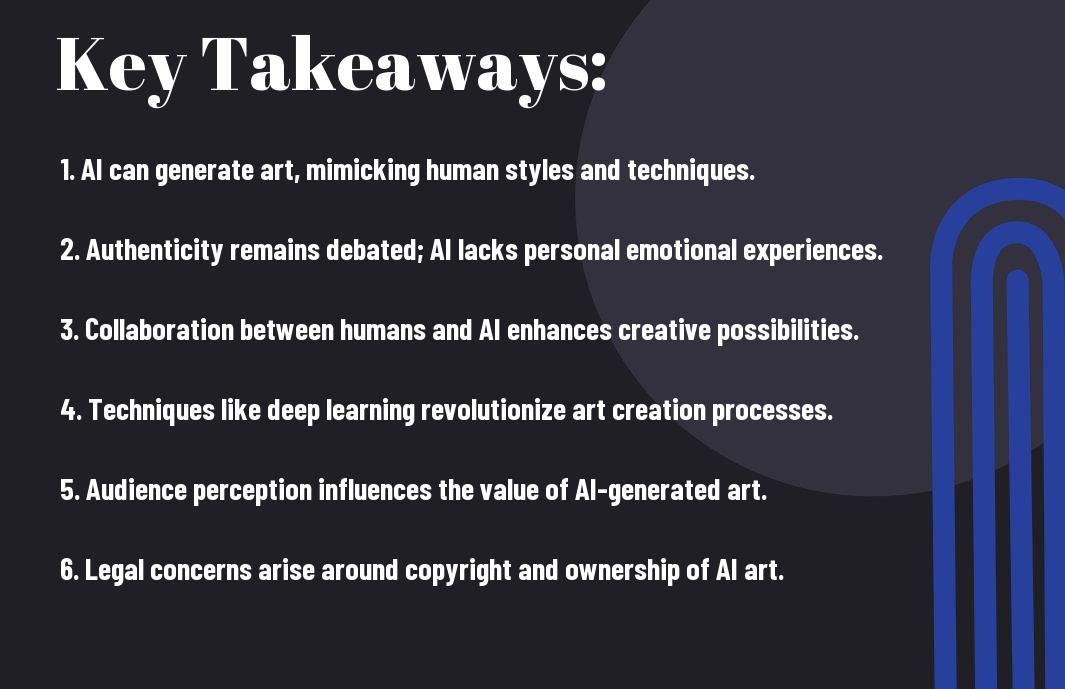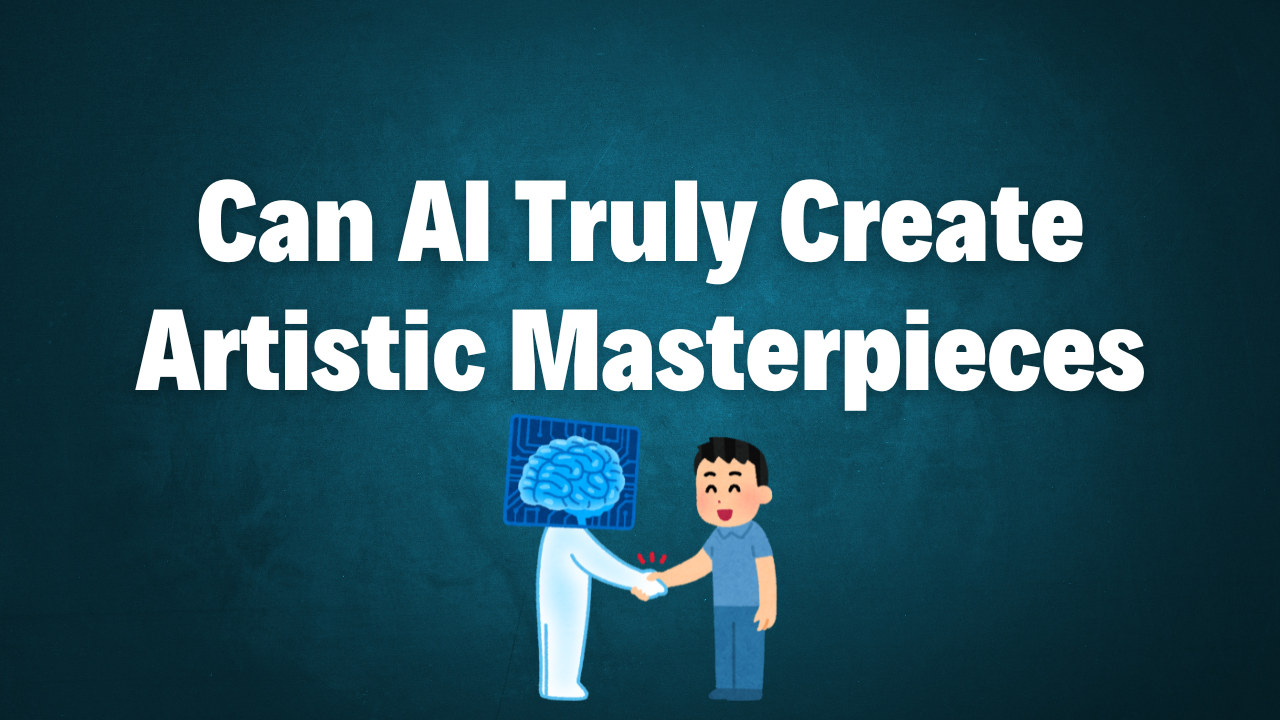Can AI Truly Create Artistic Masterpieces Most people wonder if artificial intelligence can genuinely create artistic masterpieces. As I probe into this captivating subject, I will explore the intersection of technology and creativity, examining whether AI can replicate the emotion, intent, and nuance traditionally associated with human artists. You may be surprised to learn that while AI can produce stunning visuals and music, the debate over its artistic validity is a complex one that raises ethical and philosophical questions about what it means to create art. Join me as I unravel the potential and limitations of AI in the artistic world.
Table of Contents
The Nature of Art
Before exploring into artificial intelligence and its ability to create, I believe it is crucial to explore the fundamental essence of art itself. After all, the discussion surrounding AI-generated art cannot be separated from a deeper understanding of what constitutes artistic innovation and originality. The beauty of art lies in its myriad interpretations, emotional connections, and cultural contexts, all of which shape our appreciation of what is considered a masterpiece.
Definition of Artistic Masterpieces
Any piece of art that transcends its medium to evoke profound emotions, challenge perceptions, and inspire thought can be considered an artistic masterpiece. These works often showcase extraordinary skill, creativity, and a unique vision, establishing a distinct connection with the viewer. I find it fascinating that the definition of a masterpiece is not static; it evolves over time as societal values and aesthetic preferences shift, highlighting the dynamic nature of art itself.
Moreover, the criteria for identifying a masterpiece often involve recognition from critics, scholars, and the broader art community, alongside its impact on cultural movements or historical contexts. For example, you might see how works by renowned artists such as Van Gogh or Picasso have influenced generations of creators, affirming their status as masterpieces. In this sense, the dialogue about what constitutes an artistic masterpiece is ongoing and ever-changing.
Historical Perspectives on Art Creation
With a long and rich history, artistic creation has constantly transformed in response to societal needs, technological advancements, and cultural shifts. I often reflect on the fact that ancient civilizations used art for various purposes—be it religious, political, or merely decorative. The motivation behind the creation of art has evolved, leading to different movements, styles, and philosophies throughout the ages. You might even find parallels in the way contemporary artists and AI systems approach the creative process, pushing boundaries while still rooted in their respective contexts.
Artistic evolution has been marked by significant milestones, from the Renaissance, which celebrated humanism and craftsmanship, to the explosion of modern art in the 20th century, challenging traditional notions of art. This historical journey highlights how art creation often mirrors humanity’s progression—reflecting our dreams, fears, and everything in between. As I analyze these shifts, I recognize the importance of context and the dangers of stagnation, reminding us that innovation is a crucial aspect of both human and AI creativity.

Understanding AI’s Capabilities
Even as technology continues to advance at an unprecedented pace, I often find myself pondering the true essence of artistic creation. At the forefront of this discussion lies artificial intelligence (AI), a field that has sparked both admiration and skepticism regarding its ability to produce genuine art. Understanding the capabilities of AI is crucial in determining whether it can indeed create masterpieces that resonate on a deep emotional level, and this begins with examining the technology behind AI art.
The Technology Behind AI Art
Capabilities of AI art generation primarily stem from sophisticated algorithms and vast datasets. The most prominent techniques involve neural networks, particularly Generative Adversarial Networks (GANs), which consist of two components: the generator and the discriminator. The generator is tasked with creating images that resemble the training data, while the discriminator evaluates the authenticity of these images. Through this competitive process, AI can learn to produce increasingly refined artworks that mimic human-created styles, ultimately achieving impressive results that raise questions about the nature of creativity.
Machine Learning and Creativity
Creativity in AI hinges significantly on its reliance on machine learning, a method of data analysis that enables computers to learn patterns and make predictions. In the context of art, machine learning allows AI to analyze vast collections of existing artworks, drawing insights into styles, color schemes, and compositional techniques used by renowned artists. However, this raises crucial questions: does the ability to learn from existing art imply true creativity, or is it merely a simulation of human artistic expression?
With the rise of AI-generated art, I have observed a dual-edged nature to this topic. On one hand, AI can democratize art creation by making tools accessible to individuals who may lack formal training or artistic skills. On the flip side, there are concerns surrounding copyright infringement and the potential devaluation of human artists’ work. Understanding the intersection of machine learning and creativity is critical as we navigate these complexities, as it impacts not only the future of art but also our conception of what it means to be creative.
Examples of AI-Generated Art
Keep your mind open as we explore AI art, a fascinating intersection of technology and creativity that has gained traction in recent years. From abstract paintings to intricate sculptures, AI-generated artwork runs the gamut, challenging traditional notions of artistic expression and authorship. Let’s examine some prominent AI artworks that have caught the eye of critics and art enthusiasts alike.
Prominent AI Artworks
AIGenerated works such as “Portrait of Edmond de Belamy” created by the Paris-based collective Obvious, garnered significant attention when it was auctioned for an astonishing $432,500 at Christie’s in 2018. This portrait, produced using a Generative Adversarial Network (GAN), showcases the potential of AI as a collaborator in the creative process. In addition, projects like DeepArt and Artbreeder allow users to create personalized artworks by merging different styles and images, further democratizing the art-making process.
Another notable creation comes from the team at Google Arts & Culture, who developed an AI algorithm called “Petals,” capable of generating stunning floral images based on user inputs. These AI artworks invite viewers to interact and create something unique, blurring the lines between the artist and the audience. Such innovations prompt vital questions about creativity and the role of technology in the arts.
Public Reception and Critique
Critique of AI art often revolves around the notion of authenticity and the emotional depth associated with human-created works. Some art critics argue that AI-generated pieces lack the intentionality and emotional resonance typical of human artistry. However, others appreciate the novel perspectives that AI can introduce, challenging our traditional ideas of what constitutes art and who gets to create it.
Understanding the public reception of AI art is imperative in this evolving debate. Many find the concept of machines creating art intriguing, while others express skepticism or even fear the implications of AI in the creative realm. Detractors worry about the potential for AI-generated art to overshadow human artists, affecting their livelihoods. Conversely, supporters argue that AI can serve as a powerful tool that enhances human creativity rather than replacing it. The ongoing discussions and reactions demonstrate how AI-generated art continues to provoke thought and inspire new pathways in the artistic landscape.
Implications for the Art World
After exploring the capabilities of AI in artistic creation, it is crucial to consider the broader implications this technology has on the art world. The advent of AI-generated artworks challenges the traditional notions of creativity and artistic merit, forcing us to rethink what we deem as “art.” As AI becomes increasingly sophisticated, the boundaries between human and machine-created art will blur, leading to fascinating discussions about authorship, originality, and the value we place on art itself. It raises critical questions: If a machine can create a masterpiece, does that diminish the value of human creativity?
The Role of the Artist in AI Creation
One of the most intriguing aspects of AI-generated art is the evolving role of the artist. Traditionally, artists have been viewed as the sole creators, pouring their emotions, experiences, and thoughts into their works. However, with AI becoming a collaborator in the creative process, the artist’s role shifts to that of a curator or facilitator. They must now make crucial decisions regarding prompts, data selection, and the final output, nurturing a new partnership between human intuition and machine learning.
Beyond mere tools, AI systems challenge artists to expand their own creative boundaries. By leveraging these technologies, you can explore new mediums and styles that may have been previously unattainable. This scenario opens doors to unique artistic expressions, suggesting that AI could complement, rather than replace, the artist’s vision. Still, it raises an important question: How do we define the essence of artistry in a world where machines play a role in creative expression?
Future of Art and Technology
Future advancements in AI will likely continue to reshape the landscape of art. As technology develops, the capabilities of AI to generate complex and compelling works will increase, leading to a richer tapestry of artistic possibilities. This future holds both exciting potential and significant challenges. An ever-growing amount of AI-generated art could saturate the market, making it difficult for individual artists to stand out, while also posing a threat to the economic viability of traditional art practices.
With these changes come ethical considerations that cannot be overlooked. Issues surrounding copyright, ownership, and cultural appropriation are exacerbated as machines learn from existing works. Additionally, the potential for misuse and manipulation raises serious concerns about authenticity in art. Therefore, as I reflect on the intersection of art and technology, it becomes increasingly vital for artists, technologists, and society to engage in ongoing dialogues about the implications of AI on the future of artistic expression. Together, we must navigate the challenges while embracing the innovations that such technologies bring to the art world.
Final Words
On the whole, the question of whether AI can truly create artistic masterpieces leads us into a fascinating exploration of creativity and technology. I believe that while AI can generate works that mimic artistic styles or produce visually appealing images, the essence of true artistry lies in the emotional connection and human experience behind the creation. You might find that AI can serve as a valuable tool for artists, enhancing their creative processes and offering new forms of expression. However, it lacks the intrinsic human element—experience, emotion, and cultural context—that gives art its depth and meaning.
Ultimately, the relationship between AI and art challenges us to redefine our understanding of creativity. You may see the role of the artist evolving, with AI acting as a collaborator rather than a replacement. I think it is necessary to embrace this technological advancement while also recognizing the irreplaceable qualities that human artists bring to their work. As we navigate this intersection of art and artificial intelligence, I encourage you to consider the profound implications for our culture and the future of creativity.


Pingback: Ethical Challenges in Modern Artificial Intelligence | Blog Tio